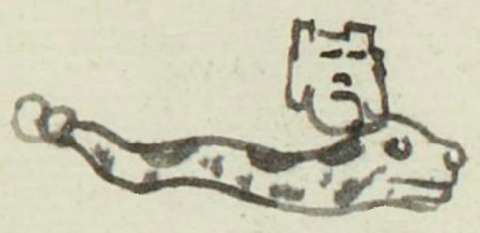Coanen (MH633r)
This black-line drawing of the compound glyph for the personal name Coanen ((“Idle Serpent," "Serpent-Divine Force Image," or "Serpent-Doll,”) is attested here as a woman's name. It shows a horizontal, undulating, spotted serpent in a profile view, facing toward the viewer's right. It has a protruding bifurcated tongue. Above the snake is the head of a doll or a figurine of a divine force (nenetl), providing the phonetic syllable "nen," usually meant to convey a negative comment about idleness or low productivity. The head has the diagnostic squared-off protrusions on the top of its blocky head.
Stephanie Wood
A famous woman of Chalco in the fifteenth century was called Coanentzin (with the reverential suffix, as she was a member of the nobility). Aside from the serpent, deciding how one should translate her name is something of a challenge. The vast majority of glyphs or glyphic elements that include the ne- or nen- syllable as a phonogram, typically expressing a negative such as idleness or low productivity, will show figurines in a frontal view. The figurines can be either full bodied, just the bust, or just the head. The syllable comes from the term nenetl, which, as translated by Alonso de Molina, means doll, deity image, or woman’s genitals. These are three very different meanings, although a doll and a figurine of a divine force/deity could have a similar look. The glyphic representations almost always show such figurines, although It can be difficult to tell if they represent dolls or deities.
One of the diagnostics for nenetl involves squared-off protrusions on the top of the head, perhaps stylized representations of the hairstyle called neaxtlahualli, where the Nahua sedentary woman wears locks of hair twisted up into two points over each side of her forehead. Fortunately, figurines with tsquared-off protrusions on their heads have survived from pre-contact times. The Museo Tomás Medina Villarruel has a number of them. These are mostly female, with skirts and breasts, and they are often shown in activities such as carrying children or grinding maize. Two images from that collection appear below. These figurines may well be dolls rather than deities. Ian Mursell has published a photo of such a figurine in an article he shares about rattle figurines. In the image in Mexicolore, the figure on the left fits the nenetl characteristics with its protrusions on its head, and since it is a rattle one could call it a female doll.
Keiko Yoneida writes about the negative reading of nenetl “fetiches” as “useless” or “in vain,” which she suggests is a patriarchal deprecation of women. See her discussion of nenetl and the nemontemi days in the calendar in her study, Los Mapas de Cuauhtinchan y la historia cartográfica prehispánica (1991), 140. A few nenetl glyphs or elements in this digital collection do not include the negative nen-, although most do, and most are female, but a few are male or genderless.
Stephanie Wood
maria
covanē
María Coanen
1560
Jeff Haskett-Wood
serpents, snakes, serpientes, culebras, víboras, esculturas, sculptures, figurillas, dolls, muñecas, ixiptla, nenetl, inútiles, cohuatl, viudas, viejas, nombres de princesas, nombres de mujeres, ondulante
Photo credit: Eduardo Flores. Museo Tomás Medina Villarruel, Tlahuac, CDMX.

coa(tl), serpent, snake, https://nahuatl.wired-humanities.org/content/coatl
nene(tl), doll or deity figure, https://nahuatl.wired-humanities.org/content/nenetl
Serpiente Inútil, o Serpiente-Muñeca, o Serpiente-Imagen Divina
Stephanie Wood
Matrícula de Huexotzinco, folio 633r, World Digital Library, https://www.loc.gov/resource/gdcwdl.wdl_15282/?sp=348st=image.
This manuscript is hosted by the Library of Congress and the World Digital Library; used here with the Creative Commons, “Attribution-NonCommercial-ShareAlike 3.0 License” (CC-BY-NC-SAq 3.0).










